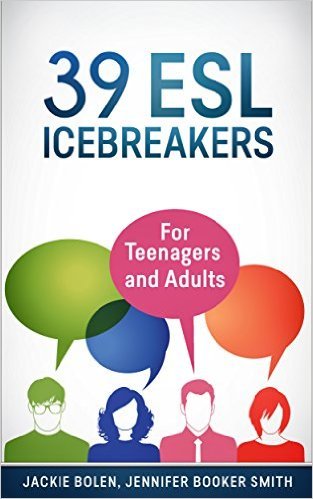If you’re looking to get your semester started off on the right foot, then you’ll need to use an ESL icebreaker. They’ll help the students get to know each other and you as well so keep on reading for the best ESL introduction games and activities.

The Best ESL Icebreakers
By starting your classes off with some ESOL icebreakers, you’re setting yourself up for a successful semester. Help your students learn English in a comfortable environment.
Keep reading for the best ESL ice breakers for adults, as well as children. You can see the detailed activity description by clicking the links!
It’s time to start your course off the right way when you teach English and help your students improve their language skills.
ESL Icebreakers for Adults, Teens and Children
Let’s get into the best ESL icebreakers when teaching English, including some activities and games to use for the first day of class.
#1: Ball Toss ESL Ice Breaker
If you’re looking for one of the most versatile EFL activities ever, look no further than this Ball Toss one. You can use it for…well…just about anything (vocabulary and grammar), but it lends itself especially well to an icebreaker activity.
Little kids love this ball toss activity, but I’ve used it with adults, and everyone in between with great results. It’s fun for you too because you get to write on a beach ball with a sharpie!
Who says your classroom can’t be fun? Try out Ball Toss to add some spice into your classes today. It’s one of my favourite ESL introduction games for kids.
#2: Toilet Paper Icebreaker
You’ve probably played this toilet paper icebreaker game before at a party, or at school. The way it works is that you take a certain number of squares and the leader doesn’t tell you why. Ring a bell? I’m sure you’ve done it before.
This toilet paper ESL Icebreaker is a classic icebreaker activity that can work in your classes as well. You can also use candy of some kind as a more fun alternative. Kids love it!
It’s perfect for those last minutes classes that get thrown at you because it requires no preparation. All you have to do is bring a roll of TP with you. This ESL introduction game is perfect for teachers to keep in their back pocket. Try out one of the best ESOL icebreakers today.

Icebreaker ESL Activities
#3: Puzzle Finder Activity
In order to complete this Puzzle Finder Activity, students have to use teamwork to finish it, making it an excellent TEFL icebreaker. Your students also have to mingle and talk to each other, which is exactly what you want on the first day of class!
And of course, the teacher should play as well. Students usually love talking 1-1 with their teacher a little bit, especially if you have a big class of 20+ students.
Try out Puzzle Finder today, a challenging, interactive ESL icebreaker for the first day of class. Your students will probably love it.
#4: Group Therapy
Group Therapy is an ESL icebreaker activity that works especially well for older teenagers or adult classes. It helps your students share the fears that they might have about the upcoming class, or learning English in general.
Group therapy ESL icebreaker is a great way for students to form connections around a common probably they might be having. Students have to go around the room, sharing something that they find difficult, or some skills that they’re lacking.
I find that doing this activity in one of the first classes helps to build a supportive, helpful atmosphere in class. Try out one of the top ESL icebreakers for adults and see for yourself! And don’t forget to participate, of course, using an example of your own language learning struggles.

ESL Ice Breakers
#5: Cosmo Quiz Classroom Icebreaker for Adults
Cosmo Quizzes make an excellent ESL icebreaker for adults, particularly a class of mostly women. But, they are most certainly only for adults so don’t even try using a cosmo quiz with kids.
You can use other age-appropriate quizzes for kids as well to get a sense of what your class is like. Search around on the Internet for these ones; you’ll find that there are a lot of choices and nice ones out there.
Need more ideas for Icebreakers for English Students? Check out: 39 ESL Icebreakers for Teenagers and Adults on Amazon
A Tip For Breaking the Ice: Change Partners Often
Students often get stuck with the same 1 or 2 people for the entire duration of the class! Help them mix things up by encouraging/forcing them to change partners often.
#6 Riddles and Trivia
One of the things that I love to do in my classes is to use trivia and riddles as a warm-up before each class. They make excellent icebreakers too if you put the students into teams and let them get to work. Nothing like teamwork to break a bit of ice in your classes!
Although I use a variety of warm-ups and icebreakers in my classes, it’s trivia that I most often go back to again, and again.
The only downside is that it can be difficult and time-consuming to write your own questions. That’s why you should check out this recommendation.
Here’s my top recommendation for trivia and riddles. The level is ideal for elementary school students who are just learning English, plus the trivia is general knowledge such that a student from any country could probably answer the questions.
Check it out now and get ready to save a ton of time:
501 Riddles and Trivia Questions (For Kids)
They’re lesson planning made easy!
Why use trivia and riddles? They expand vocabulary, are a nice dose of (semi) authentic materials, and are perfect for intermediate or advanced students. Just be sure to choose ones that your students have a hope of answering!
Of course, you can create your own questions too. The sky’s the limit, so just get creative.
#7: The Name Game ESL Icebreaker Activity
The Name Game is perfect for a smaller class of 15 students or fewer to help your students (and you too!) remember each other’s names. It works best for kids because it’s so simple. Adults may be a bit insulted by it, however, so use with caution!
The way it works is that you go around the room, in a circle and have to say a new thing about yourself, as well as repeat all the other things from the past students. It’s mostly a memory game.
Even More Activities and Games for Adults
#8 Get to Know You Games for Adults: Find Someone Who Bingo
Find Someone Who Bingo makes an excellent ESL icebreaker because it encourages your students to move around the class, talking to each other and finding out information about their classmates. It’s fun too because it’s quite challenging and there is an element of competition to it. This works well with kids as well as adults.
Basically, students have to ask other students a question in order to fill in their bingo chart. It’s fun and makes an ideal icebreaker. What terms and words to use? It’s really up to you, but try to think of things that a few students will be able to say yes to, but not everybody.
However, the instructions can get a little bit complicated, so be sure that your students have at least a basic level of English ability. And, practice how to explain this bingo game before you get to class. Think simple when you’re giving instructions. And of course, give an example or two.
#9: ESL Icebreaker Surveys
Surveys are one of my favourite ESOL activities of all-time because they get students up and out of their seats, mingling, talking and asking questions. It’s the ultimate 4-skills activity because it gets students to practice reading, writing, speaking and listening. They can also work well to review grammar.
Once you set it up, you can turn the students loose and let them get to it. All you have to do is monitor and keep an eye things. Student-centred teaching to the max! Students can work alone, or with a partner for this one.
Here are 6 ESL surveys that I use in my own classes, including an introduction one. You should of course change the ESL introduction survey to work with your own country, teaching context and age of students.
One of my favourite kinds of surveys is a “life at home” kind of one. Like how many brothers people have, where they live, what their family eats for dinner, etc. (More ideas here: Family ESL Activities).
A pro-tip: save your ESL surveys in something like Google Drive. Then, instead of making a new one each time, just edit the old one. It’ll take you 2 minutes to make a new one instead of 30 minutes to an hour. You can easily adapt a single survey to suit any level of students you may have.

ESL icebreakers questions
#10: Conversation Starters for ESL Students
Try out some of these Top 10 Conversation Starters for Adults to help your students get to know each other. You can put your students in small groups and let them get to it if you have a big class. I find that groups of 3-4 work well. Two is too few if one of the students is very shy. Five is too many for the students to really get to know each other.
If you have a small class of five or fewer, you could discuss some of them all together. Just be sure to let the students do most of the talking, not you.
You could also check out these Top 10 Discussion Starters for Children for even more ideas.
Just be sure to do some follow up with the class to make this activity as valuable as possible.
#11: Classroom Language Review For Beginners
If you teach beginners, one of the best first-day activities for them can be a review of classroom language. If you want to encourage an English-only environment, then it can be quite useful to go over things like:
- Please open your books
- Turn to page 5
- May I go to the washroom?
- Take out your homework
- Can I borrow a pen?
- I didn’t bring my book today
- You have 5 minutes to finish this
- What does this word mean?
- I don’t understand
- Etc.
And tips for teaching classroom language that you’d like to add?
#12: The Expert ESL Speaking Activity
If you teach intermediate or advanced level students, then you’ll want to seriously consider trying this conversational activity out. It’s perfect for helping students get to know a few other students on a deeper level and it’s one of my favourite ESL icebreakers.
The way it works is that students have to think about a few different things that they’re an expert in. It could be as simple as cooking an egg perfectly. Or, it may be a subject they study at school or a hobby. Then, they narrow these down to a few that they think others may be interested in.
Finally, students have to have a few mini-conversations with another student about these topics. Sounds like it might work for your class? Learn more about this ESL classroom icebreaker for adults activity here:
The Expert Ice Breaker Activity
#13 ESL Icebreakers: Find Something in Common

Find Something in Common-ESL Speaking Activity for Adults
Are you looking for a fun ESL conversation activity to try out in your classes? And, one that also requires nothing in the way of materials or preparation?
Then keep on reading to find out more about “Something in Common,” that works well for both intermediate and advanced level students. It’s an ideal ESL activity to have in your back pocket in case of emergency—a last-minute class thrown at you with no advance warning.
Skills: Speaking and listening
Age: Teenagers or adults
Level: Low-intermediate to advanced
Materials Required: Pen and paper
Time: Depends on the class size, but usually 10-15 minutes
If your students are not shy, this ESL speaking activity for adults is an excellent way for everyone to get to know each other. Here’s how you do it:
The students stand up with a piece of paper and pencil in their hands. They have to talk to everyone in the class to try to find something in common (they are both from Seoul, or they both know how to play the piano).
Once they find this thing in common, they write it down along with the person’s name. They keep going until most of the students have talked to everyone.
If you have a very large class, don’t keep going until students have talked to every single person because it can get boring. 10 minutes is about the maximum amount of time you’ll want to do this for an ESL Icebreaker.
Procedure for one of my Favourite ESL Icebreakers:
- Students get a piece of paper and a pencil.
- Explain how the activity works and do one or two examples with a student(s).
- The students stand up and find someone to talk 1-1 with.
- They have a short conversation and try to find something in common. For example, they both love pizza, or play soccer.
- Each student quickly writes it down (Dong-Hyun: soccer) and then moves on to find a new partner.
- The activity is finished when the student has finished talking to everyone, or the time is up.
- You can follow-up with the class by asking if any students found out something really interesting.
Teaching Tips For Find Something in Common:
This is a particularly good activity for a class where many students don’t already know each other. If your students find something in common with another student, they’ll have something to talk about after class, or at break time, and won’t feel so alone in the class, which will make it more enjoyable and memorable.
Tell your students that it is okay to have short conversations about the thing they have in common, the goal of the activity is to try to talk to most of the people in the class so they need to keep moving and talking to new people.
This is an activity that requires nothing in the way of preparation or materials, so keep it in the back of your mind in case of emergency in one of your higher-level classes.
#14: Just a Minute ESL Introduction Game
Another one of my favourite ESL speaking activities for intermediate or advanced level students is Just a Minute. It’s challenging, but fun and makes a quick warmer activity.
#15: Would you Rather
You’ve probably done would you rather informally with friends or family before. You can choose either two positive things like going out for Italian food or Thai. Or, two negative things like dying in a fire or drowning. It’s easy to adapt this game to play with your English learners too for any age and level or student.
The best part is that it creates some very interesting conversations. It’s also a nice way for students to get to know each other a little bit. Do you want to find out more? Check this out: Would you Rather for EFL.
#16: Make a Line or a Blob
This is one of my favourite ESL icebreakers because it’s so simple but the students really enjoy doing it. The way it works is that students have to line up, in order according to something (age, birthday, height, etc.) without talking.
Or, students can blog together according to favourite food, how they got to school, etc. In this case, you can allow talking or this activity will be impossible!
#17: Hot Potato
#18: More Ideas for TEFL Icebreakers
#19: This/That
I really like this ESL ice breaker because it gets students up and out of their seats moving around the classroom. The way it works is that you ask a true/false, yes/no or would you rather question. For example:
- You are in your third year of university (true/false).
- Do you have two or more siblings? (yes/no).
- Would you rather be rich or famous?

Top 20 ESOL icebreaker activities and games
#20: 2 Truths and a Lie
This is a classic ice breaker activity for any group of people. The way it works is that students have to write two true statements about themselves and then one lie. The other people have to decide which one is the lie and then vote on it. The winner is the person who spotted the most lies.
#21: Twenty Questions
#22: Sit Down
Everyone stands up and the teacher can ask a series of random, fun questions. For example:
- Sit down if you have are an only child.
- Sit down if you don’t like pizza.
- Etc.
And so on it goes until only one person is left standing!
- Amazon Kindle Edition
- Bolen, Jackie (Author)
- English (Publication Language)
- 114 Pages - 05/30/2015 (Publication Date)
#23: Continue the Story
Come up with some fun story starters and students have to work together to finish it. For example:
- I was walking to school when . . .
- As soon as I woke up . . .
Then, each student has to write one sentence and pass it along to the next student. Finally, you’ll have a number of funny stories.
#24: Running Dictation
What is an Icebreaker in Teaching?
An icebreaker is a simple activity or game that helps the students and the teacher get to know each other, as well as the students to learn a bit more about each other. The best icebreakers for teaching require little preparation and are easy to use in class. They can help to set you up for success in your class.

What is an icebreaker activity for teaching?
What are some ESL Icebreaker Questions for Adults?
Do you have a new student or group of students and you want to break the ice with some icebreaker questions and general chit-chat before getting into your lesson? Here are some of my top recommendations for icebreaker questions and ESL small talk for your adult English learners:
Do you have any pets?
How long does it take you to get to school (here)?
What was the last book you read or movie you’ve seen?
Did you take a vacation this winter (or summer) break?
Do you like to cook?
What do you like to do in your free time?
Do you have any restaurant recommendations for this area?
Do you speak other languages besides English and your (first language)?
Have you heard about any interesting events coming up in our city?
If you had a million dollars to spend, what would you do?
If you could change something about your country, what would it be?
What do you like to do for fun?
Do you have any icebreaker questions or random conversation questions for adults that you’d like to add to this list? Comment below with your recommendations and I’ll be sure to add them!
Did You Like These ESOL Icebreakers?
Do you want to get your courses started off on the right foot by breaking the ice and helping the students get to know you, and each other? Yes? Thought so. Who wouldn’t want this, right?
Then you’ll need to check out this book: 39 ESL Icebreakers available on Amazon. There are dozens of top-quality ESL activities and games to help to break the ice. Keep on reading to learn more about the popular ESL activity book.
ESL Icebreakers: For Teenagers are Adults
All English teachers who work with teenagers or adults need some ESL icebreakers to get their classes started off on the right foot when students don’t know each other, or you.
Icebreaker activities are the perfect tool for the job. However, it’s not easy to find the best ones.
Stop Wasting your Time
If you’re tired of wading through the junk on the Internet to find the one activity that you can actually use in your class, then help is here.
During her decade of experience as a CELTA/DELTA certified teacher, Jackie Bolen has developed countless games and activities for her students. Jennifer Booker Smith taught kids for years before moving into teacher training. She then moved back into the classroom again. Jennifer has a passion for developing games and activities that students really enjoy.
Almost 40 Top-Quality Activities
They’re sharing their ideas for icebreakers with ESL teachers throughout the world. In 39 ESL Icebreakers, you’ll get over three-dozen ideas to use in your own classroom. The highly-detailed descriptions will show you exactly how to use the activities during your lessons.
It’s lesson planning made easy, guaranteed. This is the book that belongs on every English teacher’s personal bookshelf.
Ideal for Busy Teachers
If you’re extremely busy or you’re simply out of new ideas, Jackie and Jennifer’s book makes it easy to try out new and exciting activities your students will love! Buy the book to make sure you get your semester started off on the right foot with students getting to know each other as well as you. You’ll find that the rest of your course goes more smoothly.
Students love to be in a class where they know the other students well. Help them down that path with these top-quality ESL icebreakers.
Buy 39 ESL Icebreakers on Amazon Today
You can get 39 ESL Icebreakers: For Teenagers and Adults on Amazon. Are you ready to take your first couple of classes of the semester to the next level? Then, you’ll need this: 39 ESL Icebreakers: For Teenagers and Adults.
Available in Various Formats
The book is available in both digital and print formats. The cheaper electronic version can be read on any device-Kindle, Smartphone, tablet, Mac, or PC. You just have to download the free Kindle reading app first. It’s super easy to have top-quality ESL ice breakers at your fingertips anywhere you go.
Keep a copy on the bookshelf as a handy reference tool. Or, take a look at the copy on your phone or tablet when doing lesson plans at your favourite coffee shop.
Shop Now
Check out the book for yourself on Amazon. Are you ready for some ESL lesson planning awesome?
What Makes a Good ESL Icebreaker?
Teaching English is an important job and there are a lot of factors to consider. If you’re choosing an ice breaker, or designing your own, here are some of the characteristics of the best ones:
Low Social Risk
The worst ones put students on the spot in front of the entire class who they may barely know! The best ones require just talking to 1 or 2 people at a time.
ESL Icebreakers that are Not Too Personal
Think hobbies, favourites sports, job, hometown, family, etc. instead of deepest, darkest secrets. You want to allow students to get to know each other but not have to divulge too personal information to people they don’t know.
They Match Proficiency Level
You may have to design or choose different icebreakers for different classes. For example, what works for a group of beginners may not work well for an advanced level class or a group of intermediate students.
ESL Icebreakers: They’re Fun!
If your ESOL icebreakers are lame, nobody is going to want to do them. They should be fun, a little bit challenging, and best of all, give students a reason to talk to each other.
Don’t Forget to Evaluate ESL Icebreakers
After each activity you do in your English classes, be sure to evaluate it. For these ones, was is too easy or too difficult? Did the students have fun? Did it help them get to know each other? Were your directions clear and easy to understand?
Don’t be afraid to make changes!
They Help People Get to Know Each Other
The goal of any ESOL ice breaker should be for each person to get to know at least one other person. That way, when they come into the class next time, there’s a friendly face for them to say hello to. Keep this in mind when you’re designing your activities.
What is the Purpose of an Icebreaker Exercise?
The purpose of an icebreaker exercise is to help a group begin the process of forming into a team and being able to work together. They also help group members get to know each other more easily.
Let’s Sum This Up about ESL First Day Icebreakers
Getting to know other people in the class shouldn’t cause serious anxiety and stress. Nor should any student feel worried or scared if they’re alone and don’t have a friend in the class with them.
Some good introduction activities will help your students get to know their classmates (and you) in a relaxed, fun kind of way. My hope is that a student finds someone who grew up in the same hometown, has a similar hobby, or favourite food.
The best ones don’t require a higher level of English than matches the ability of the students. They don’t require too much personal information, yet they give students a reason to talk to each other.
Finally, they can put your students at ease with you as a teacher. If you use the first class to do some interesting activities, students will feel that they’re in good hands.
Are you up for the challenge? I hope so. A good ESL ice breaker activity can really go a long way towards setting you up for success throughout the rest of the semester.

ESOL ice breakers
What’s your favourite ESL Ice Breaker for Adults?
What are your favourite ESL icebreakers? Leave a comment below and let us know what you think. We’d love to hear from you.
Oh yeah, and please share this on Facebook, Twitter, or Pinterest, or contact us if you have any questions. It’ll help other busy teachers, like yourself, find this useful resource.
And you can also check out the rest of this blog. It’s chock full of useful tips and tricks, games and activities for teaching English to children or adults.
Last update on 2025-06-12 / Affiliate links / Images from Amazon Product Advertising API









These are wonderful ideas. Thank you for sharing them.